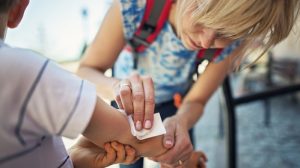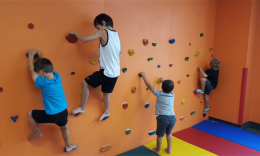Building a First Aid Kit

When you think about Emergency Preparedness, a big event or a natural disaster often comes to mind. However, the truth is most organizations will likely experience smaller-scale incidents in their day-to-day activities. In the quest to achieve a high standard of emergency preparedness, don’t overlook the little things that will keep families safe, like a First Aid Kit.
Now is the perfect time to reevaluate and restock your kit. The first aid kit and other emergency supplies should be kept in a closed container, in a location that is labeled and easily accessible to staff, volunteers, and leadership but out of reach for children. Make sure the location of your kit is clearly marked because an emergency is the worst time to have to search for what you need.
Depending on how quickly you go through supplies, complete either a monthly or quarterly inventory to help eliminate expired supplies and keep on hand everything you need. Ideally, each kit should be restocked after every use, but that may not be possible during busy times of the year. Instead, try keeping a log of who completed the inventory check and restocked supplies.
When deciding on what to include in your First Aid Kit, there are numerous choices and several pre-made kits available to purchase. At a minimum, here’s what should be included in your kit.
First Aid Kit Items:
- Writing utensil & notepad
- Disposable latex-free gloves
- Single-use face masks
- Scissors
- Tweezers
- Thermometer: We recommend an ear thermometer such as the Braun Thermoscan. It has quick readings and a lens filter detector, which means you don’t have to sterilize after each use.
- Bandage tape
- Sterile gauze pads
- Flexible roller gauze
- Triangular badges
- Safety pins
- Eye patch
- Cold packs
- Distilled or sterile water: This is used for washing out eyes or cleaning wounds.
- Liquid soap and hand sanitizer
- Tissues & wipes
- Adhesive strip bandages
- Plastic bags: These can be used for disposing of materials that have been used or soiled.
- Flashlight & whistle
- Extra AA and Triple-A batteries
Portable First Aid Kit Items:
Portable kits should include all the items mentioned above as well as the following additional pieces.
- A complete attendance list with emergency contact information for each child.
- Care plans for children with special needs and include emergency medications or supplies.
- An emergency contacts list includes Poison Control Center, local first responders, area hospitals, and emergency clinics.
- Local area maps in case the internet goes down.
A well-stocked first-aid kit should be a staple in your facility as well as anywhere kids and youth gather. Accidents happen, and having the correct tools to respond can be a lifesaver.
If we’ve missed any items, please share them in the comments below.
For more safety information, Join our growing social community. You can subscribe to the KidCheck Blog or find us on YouTube, Twitter, Facebook, Pinterest, and Instagram.
Click here to learn more about the benefits of secure children’s check-in and how it can help your organization attract new families, improve child safety, and balance workload.


